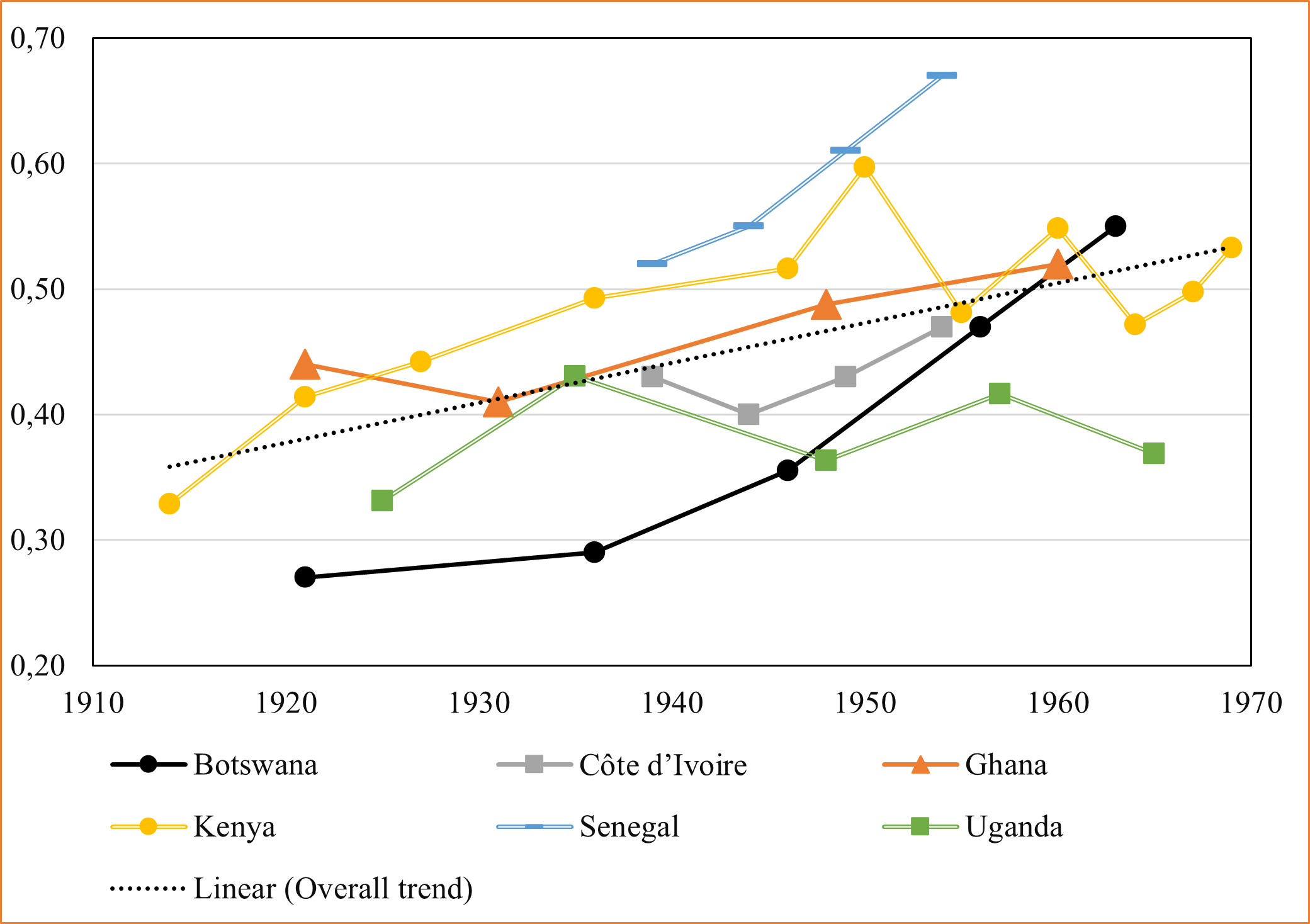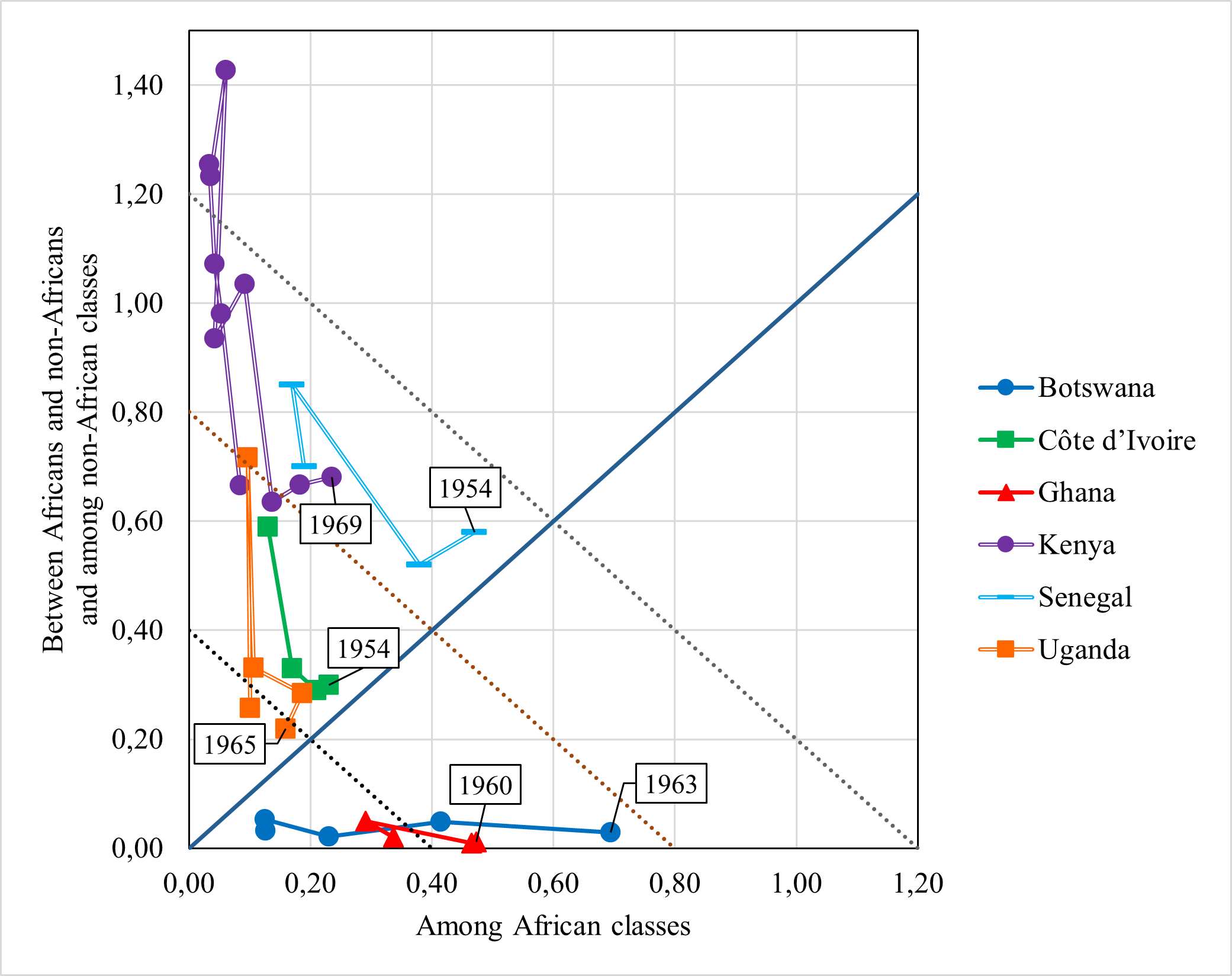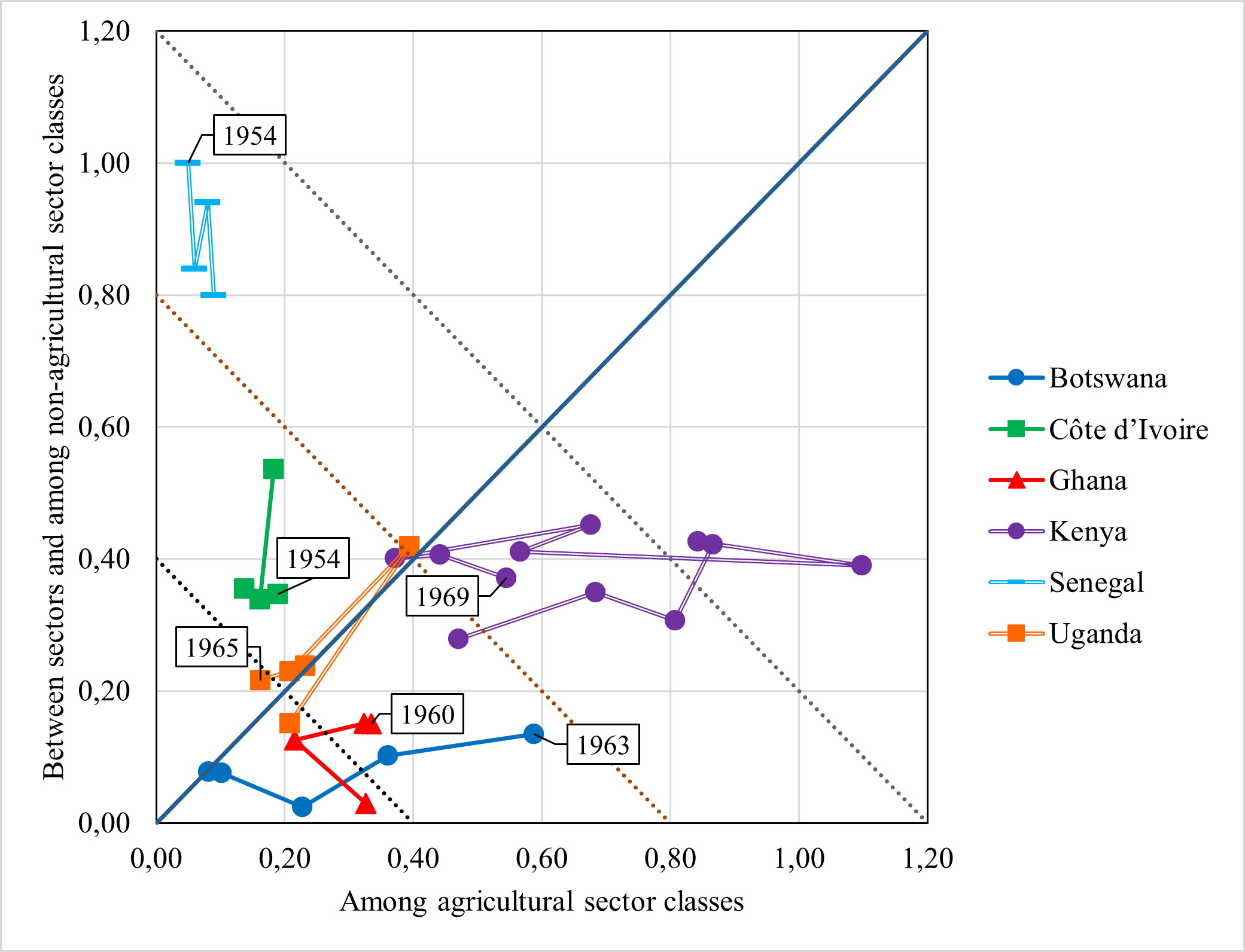Using evidence from 33 social tables, we investigate the relationship between export-oriented commercialization and income inequality in six predominately agricultural African colonial economies between the 1910s and 1960s. We find that, overall, inequality rose over time, and differences between colonies were linked to the presence of non-Africans and the capital intensity of different export commodities.
Today, Africa is characterized by substantial variation in within-country income inequality covering a spectrum from relatively equal economies in West and North Africa to highly unequal countries in Central, Eastern, and especially Southern Africa. There is growing scholarly interest in measuring current and historical inequality levels in Africa (World Inequality Lab, 2023) and understanding its underlying dimensions and determinants (Bigsten, 2018; Frankema et al., 2023). However, the lack of consistent data limits our understanding of the legacy of past inequality trajectories on present-day inequality. Therefore, Africa has featured marginally in the literature on global inequality. Our study contributes to rectifying this situation.
Social tables to measure inequality
We build inequality estimates derived from social tables, simplifying a country’s income distribution by identifying a limited number of classes and assuming a uniform income within each class. Social tables are constructed in such a way that they capture streams of non-monetized income and proceeds from commercial farming. They inform us about the incomes of self-employed groups and wage-earners and allow us to investigate between-group income differentiation across the full income distribution in contexts of limited data availability (Milanovic et al., 2011). Social tables can be used to compute various inequality indicators, of which the Gini coefficient is the most well-known.
We use and, where necessary, modify 33 social tables for six African countries – Botswana, Côte d’Ivoire, Ghana, Kenya, Senegal, and Uganda – covering the period 1914 to 1969 (Aboagye & Bolt, 2021; Alfani & Tadei, 2019; Bigsten, 1987; Bolt & Hillbom, 2016; De Haas, 2022). Currently, work is ongoing to construct additional social tables and to improve existing ones. At present, however, this is the full universe of repeated social tables for the entire population constructed for sub-Saharan African economies for our period of interest.
Drivers of inequality in colonial Africa
We point out two extant explanations for inequality outcomes in colonial Africa: first, the “dual economy” of high wage incomes of expatriate groups and formally employed Africans versus low (agricultural) incomes for most self-employed Africans; second, the increasing participation of African colonial economies in international commodity trade. The latter fostered a process of commercialization and boosted income-earning opportunities in the export sector. This benefited regions, ethnic groups, and social layers unevenly. We argue that the extent to which commercialization drove inequality depended on the capital intensity of the commodity, with more capital-intensive commodities generating more scope for inequality.
Our six country cases all experienced substantial export-oriented commercialization based primarily, but not exclusively, on various agricultural commodities (cocoa, coffee, cotton, groundnuts, and livestock). Further, they constitute diverse economic structures and colonial institutions, including “peasant” and “settler” economies, with a variation in the prevalence and roles of Asians and Europeans. Thus, the sample contains sufficient variation for a novel and informative comparative analysis of how export-oriented commercialization and expatriate presence affected income inequality in African agrarian societies within different colonial economic structures.
Main findings
We calculate different measures of economic inequality, each with distinct characteristics. As our baseline metric, we use the Gini coefficient (Gini henceforth), the most used inequality measure. Given that we are not only interested in the incomes of (European) top-income classes but also those of African commercial farmers and wage earners, the Gini has a significant advantage in that it is responsive to changes in the middle of the income distribution. We also calculate Inequality Extraction Ratios (IER henceforth), which consider that the scope for inequality increases as economies become more prosperous and more “surplus” income is generated beyond basic survival (Milanovic et al. 2011). As such, it provides a more conservative approach to inequality increases in periods of economic growth, which accounts for the ‘mechanical’ increase in inequality caused by economic growth. Finally, we consider the Theil coefficient (Theil henceforth), which is more responsive towards changes at the extreme ends of the income distribution than the Gini coefficient but has as its main advantage that it is fully decomposable.
We obtain four key findings. First, during the colonial period of export-led economic expansion, overall inequality increased but with substantial variation across individual countries (see Figure 1). Second, we find that changes in inequality were positively associated with agricultural commercialization: in years that export volumes (measured in constant prices) rose, so did the Gini.
Figure 1. Gini Coefficients

Source: Hillbom et al., 2023.
Third, by decomposing inequality by race (see Figure 2), we establish that racial cleavages in the colonies with a larger proportion of expatriates in the population – Kenya and Senegal – accounted for a large proportion of overall inequality. Meanwhile, African inequality was lower in colonies with more settlers than in colonies with limited European and Asian settlement. This suggests that fewer opportunities existed for Africans to benefit from the export economy when more expatriates were present. These patterns indicate that colonial settlement played a significant role in determining how the incomes from export-oriented commercialization were distributed, echoing experiences in other colonial contexts such as Latin America.
Figure 2. Theil decomposition by race

Source: Hillbom et al., 2023.
Notes: The diagonal lines (top left to bottom right) are ‘inequality indifference lines.’ Along these lines, the total Theil index is constant. The line separating the top left and bottom right halves of the graph illustrates the decomposition where the ‘expatriate’ and ‘African’ components are equal. All points below this line indicate that inequality among Africans contributed more to the overall Theil index than expatriates and vice versa.
Figure 3. Theil decomposition by sector

Source: Hillbom et al., 2023.
Notes: For information on reading and interpreting this graph, see Figure 2.
Fourth, by decomposing inequality by sector, we observe substantial inequalities within the agricultural sector (see Figure 3). Towards the end of the period, countries exporting more capital-intensive commodities (cocoa, livestock) saw higher inequality in their agricultural sector than those exporting more labor-intensive commodities (cotton, groundnuts). Albeit not conclusively, our results also suggest that specialization in capital-intensive commodities was associated with higher inequality in the agricultural sector, especially towards the end of our period.
References
Aboagye, P. and Bolt, J. (2021). Long-Term Trends in Income Inequality: Winners and Losers of Economic Change in Ghana, 1891-1960. Explorations in Economic History, 82: 101405.
Alfani, G. and Tadei, F. (2019). Income Inequality in French West Africa: Building Social Tables for Pre-Independence Senegal and Ivory Coast, UB Economics Working Papers 2019/396.
Bigsten, A. (1987). Income Distribution and Growth in a Dual Economy: Kenya 1914-1976. Gothenburg University, Department of Economics, Memorandum nr 101.
Bigsten, A. (2018). Determinants of the Evolution of Inequality in Africa. Journal of African Economies, 27 (1): 127-148.
Bolt, J. and Hillbom, E. (2016). Long‐term trends in economic inequality: lessons from colonial Botswana, 1921–74. The Economic History Review, 69: 1255-1284.
De Haas, M. (2022). Reconstructing income inequality in a colonial cash crop economy: five social tables for Uganda, 1925-1965. European Review of Economic History, 26 (2): 255-283.
Frankema, E., De Haas, M., and Van Waijenburg, M. (2023). Inequality regimes in Africa from pre-colonial times to the present. African Affairs, 122(486), 57-94.
Milanovic, B., Lindert, P.H. and Williamson, J.G. (2011). Pre‐Industrial Inequality. The Economic Journal, 121: 255-272.
World Inequality Lab (2023) (https://inequalitylab.world/en/)
Feature image: Unequal scenes in Tanzania. Credit: Johnny Miller. https://unequalscenes.com/tanzania
Publisher: Source link











